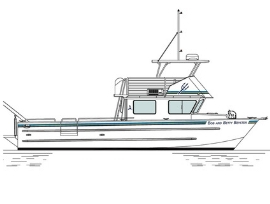The Bob and Betty Beyster became the newest research boat to join the fleet at the Scripps Institution of Oceanography at the University of California San Diego.
The 42-foot aluminum hulled boat built by Armstrong Marine of Port Angeles, Washington, was carefully designed for its work in Southern California and the Channel Islands. Our marine team worked closely with Armstrong and researchers to outfit the Bob and Betty Beyster with a propulsion system specifically tailored to the needs of researchers.
“We took a lot of time with the Scripps team to determine exactly what they needed from the functionality of the boat,” said Doug Schwedland, vice president of our marine division. “Part of that planning included taking the Scripps people out on a boat equipped with Volvo Penta’s IPS system. That really allowed us to fine tune the propulsion package to meet all their criteria.”
The Fleet
In its more than 100 years of existence, the Scripps Institution of Oceanography has become one of the most prestigious centers for ocean, earth and atmospheric science research, education and public service. The organization’s fleet has plied the waters along the West Coast, Alaska, Indonesia and Mexico, gathering critical data that has helped guide marine industries and governments in making policy decisions.
Vessel’s Namesake
The Bob and Betty Beyster was named to honor the philanthropy of the late Dr. J. Robert Beyster and his widow, Betty. Robert Beyster, a graduate of the University of Michigan’s engineering school, founded Science Applications International Corporation, which grew into a Fortune 500 company.
Testing Volvo Penta’s IPS
Much of the research work the newest Scripps vessel will conduct requires operating at slow speeds performing tasks like mapping the ocean floor. The ship’s twin catamaran hull provides a stable platform to operate under those conditions.
Schwedland said researchers made several trips with our marine team on a leisure boat outfitted with a Volvo Penta IPS system. The goal was to learn from researchers how they need the boat to operate in order to do their work.
Propulsion System
Complementing the ship’s design is Volvo Penta’s 6-cylinder D11, 10.8-liter engine with twin-entry turbos. It is matched with the IPS2 pod, twin counter-rotating propellers and the Electronic Vessel Control System, which includes a joystick control to direct the boat’s movements. The IPS system, which is moving from the leisure boat market to commercial vessels, gives the operator fine motor control of the boat for delicate maneuvers.
The boat also has Volvo Penta’s Dynamic Positioning function, which utilizes the ship’s GPS coordinates to hold the vessel’s position and heading like an invisible anchor. The ability to remain in one spot for a long period of time is critical for researchers to gather data for their research.

